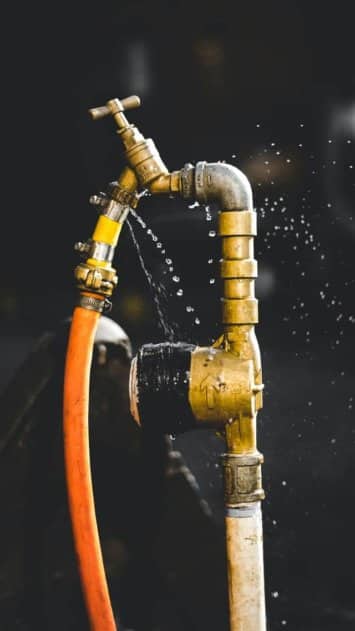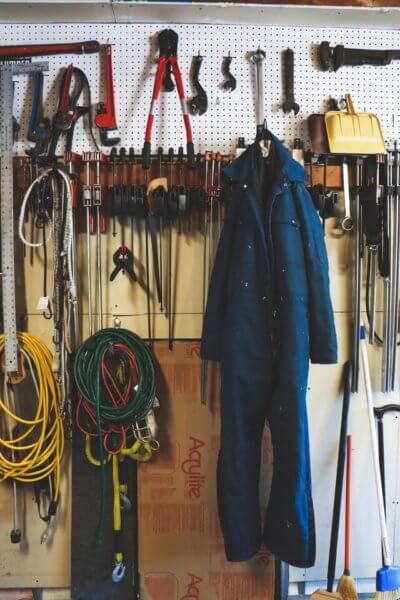Are you a DIYer passionate about home repairs and projects? Or maybe you want to be prepared for potential plumbing issues like a burst pipe? In that case, you should make your plumbing tools list.
Having the right plumbing tools in case of emergency is vital. Plumbing tools and their uses can make the difference between a flooded apartment and keeping things under control. What plumbing tools do I need as a cautious homeowner? Keep on reading to find out!

This plumbing tools list contains:
- Basin wrench
- Adjustable wrench
- Tubing cutter
- Tongue-and-groove pliers
- Metal file
- Abrasive mini strips
- Plumber’s tape
- Plunger
- Snake
- Screwdrivers
- Propane torch
- Silicone cartridge gun
- Goggles, boots and gloves

1.Basin wrench
This cheap and yet very useful tool is required for tightening and loosening nuts that hold sink faucets in place. Also called a sink wrench, it enables you to turn fasteners in confined spaces. Some nuts used to secure faucets to sinks can be located in hidden places that are only accessible to a basin wrench.
Tips on how to use a basin wrench include:
- Setting up the wrench correctly
The wrench is positioned differently for loosening and tightening. Do this before you get under the sink. When trying to remove a faucet, the opening of the claw should be facing the right. When attaching it to the nut, you need to turn the wrench in the opposite direction.
- Gripping the mounting nut
The claw head should grip the notches of the nut, with the possibility of repositioning yourself at any moment.
- Turning the wrench
Use both hands to turn the wrench by grabbing the T-bar. This method is more effective than turning the shaft.
2.Adjustable wrench
Also known by the brand name Crescent wrench, this tool helps you remove fixtures from shutoff valves and compression nuts. Because it has smooth jaws, it will not damage chrome surfaces.
The adjustable wrench is an open-end wrench with a movable jaw. This makes it possible to use it with different fastener head sizes. In USA and Canada, the tool is known as Crescent wrench due to the company which patented its design in 1915.
There are multiple reasons to keep an adjustable wrench in your toolbox. This smart tool can also be used for auto repairs, removing wheels, and self-assembly furniture.
3.Tubing cutter

It is possible to cut plumbing pipes with a hacksaw, but tubing cutters are more appropriate. There are different types of tubing cutters, depending on the materials that tubes are made from:
- Copper
- PVC plastic
- PEX
Benefits of using a tube cutter instead of a hacksaw include:
- Producing a cleaner cut
- Not having to remove burr after cutting
- Cutting the tubes faster
This tool does have a disadvantage, though. It is limited to pipes of a smaller size. If you want to cut larger pipes, you may need a hacksaw.
4.Tongue-and-groove pliers
Tongue-and-groove pliers are a type of slip-joint pliers. They have replaced the numerous pipe wrenches plumbers had to carry with them in the past.
Also known as Channellock pliers, this tool has angled jaws and long handles. Multiple adjustment positions can be used. For your home toolkit, a standard 10-inch size should do. For more complex projects, it would be good to have both larger and smaller version of the tool.
The increased leverage of tongue-and-groove pliers makes the tool suitable for the following uses:
- Turning and holding nuts and bolts
- Gripping various objects with irregular shapes
- Rotating objects
- Twisting and holding
- Tightening and loosening
5.Metal file
Metal files are used to remove burrs and to smooth the edges of metal pipes after cutting.
Burr is the formation of rough edges or ridges on a metal piece. This occurs also in manufactured metal parts due to the tools involved in their production. Even laser cutting and plasma cutting will produce burr on metal sheets. When it comes to plumbing, burrs occur when cutting pipes with a hacksaw.
Burr must be removed for the following reasons:
- Reduced safety – the person handling the pipes can hurt themselves with the sharp metal edges;
- Carrying a risk of increasing stress on the pipe during operation, which can cause fatigue and fractures faster;
- The difference in material thickness can increase susceptibility to corrosion.
So, a metal file is a must-have tool in your plumber’s kit. It will enable you to give that professional look to your job and to avoid all kinds of problems.
6.Abrasive mini strips
The modern alternative to sandpaper, steel wool, and emery, mini strips can be used both in dry and wet conditions. The best abrasive mini strips are waterproof, washable, and non-clogging. They are not used just in plumbing, but also for a variety of other trades.
7.Plumber’s tape
Alternatively known as thread sealing tape, plumber’s tape is on your plumbing tools list.
When joining pipes, connections will leak without a sealing material.
Choose a quality sealing tape that can withstand both low and high temperatures. The most common material used for this product is PTFE (polytetrafluoroethylene). Or Teflon if this name sounds more familiar to you. This amazing material is able to resist to a temperature range between -268°C and +260°C.
The tape should be wrapped around a pipe’s thread three times before screwing it into place.
The Teflon seal in plumbing will prevent pipes from leaking and comes in white or pink color. Some plumbers prefer pink sealing tape as it seems to provide the best integrity. The white version is preferred for aesthetical reasons, while the yellow type is designed for gas pipes.
Make sure you never run out of plumber’s tape – this item is compulsory when you are making thread connections. No matter how precisely you work, without sealants, your pipes will leak.
8.Plunger
The plunger is the first choice when needing to handle a routine clog in a sink, shower, or tub. There are two types of plunger:
- Cup plunger which has a rubber cup that fits over the drain opening;
- Flange plunger or toilet plunger, designed to fit the drain opening of a toilet.
Plumbers use heavy-duty flange and cup plungers which produce more suction than the average plunger. There are even water vacuums that are able to suck up water. However, this is a professional tool and it is not worth spending money on one unless you are a plumber.
9.Snake
The plumber’s snake or the drain auger is the last DIY resort when dealing with a stubborn clog.
The snake is a spiral ¼ inch thick that works the opposite way a plunger does. If the plunger sucks out the clog, the snake pushes it further down the drain. Their main advantage is being long enough to reach clogs located deep down the drain.
There are some downsides to using a plumber’s snake:
- The job site can get quite messy and you will have to clean the tool after use – 50 feet of long, flexible cable;
- Snakes are riskier to use as they can tear up pipes and cause leaks;
- You may have to remove the P-trap to use a snake. The P-trap is the curving piece of pipe under the sink that prevents sewer gases from rising out of the sink and into your home. Since you are removing it, you must also inspect and clean it thoroughly.
10.Screwdrivers
Screwdrivers are necessary because you may have to remove all kinds of screws when doing plumbing repairs. Consider multi-bit screwdrivers like the ones on this list to save space and money. [source]
Some plumbers recommend stubby screwdrivers, which facilitate access to screws located in hidden areas. This type of screwdriver is shorter than regular ones, enabling you to reach screws obstructed by pipes and other parts.
11.Propane torch
Propane torches like these ones available on Amazon are used for the following operations:
- Soldering copper water pipes;
- Softening old paint;
- Loosening rusted bolts.
This tool applies a flame or heat by using propane as fuel and provides the following benefits:
- Being able to warm up frozen pipes within minutes;
- Shrinking pipe fittings or protective sleeves;
- Having a flame extinguisher feature;
- Being able to sue it tilted or inverted;
- Changing the flame size for different application.
If you decide to use a propane torch, add a fire extinguisher and a fire-resistant clot to your plumbing tools and materials. Flames can easily get out of control.
12.Silicone cartridge gun
Also known as a caulker gun, the silicone cartridge gun is an easy-to-use sealant for DIYers. The benefits of silicone sealants are both functional and aesthetical.
Additional items you will need for a sealing job are:
- Putty knife
- Silicone sealant remover
- Cleaning cloths
- Masking tape
- Surface cleaner
- Gloves
- Smoothing tool
Before applying silicone sealant, prepare the surface by removing dirt or old sealant. Tape both sides of the space you want to fill. Apply sealant without removing the tip until reaching the end.
Smooth over the sealant with a suitable tool and remove the masking tape carefully.
13.Goggles and gloves
Not using personal protective equipment for plumbers can lead to a variety of accidents. The basics include goggles and gloves, but for some projects, you might also need boots and a protective helmet.
Goggles are compulsory when using power tools, while gloves are needed because plumbing can be a dirty job.
Plumbers use protective equipment to keep themselves safe but also to create a professional image and give homeowners peace of mind.
Conclusion
Is your plumbing tools list completed? The answer to this question depends on the type of plumbing job you want to finish. Consult our list of plumbing tools and their uses while also ensuring you have the plumbing essentials in your home toolkit. And don’t forget about safety either!

Michael Davis is a heating & plumbing expert who currently works as independent contractor in SC. He also writes for Plumbertip.
For almost 10 years he worked on various plumbing tasks across South Carolina.



